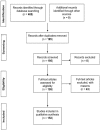The relevance of stretch intensity and position-a systematic review
- PMID: 26347668
- PMCID: PMC4540085
- DOI: 10.3389/fpsyg.2015.01128
The relevance of stretch intensity and position-a systematic review
Abstract
Stretching exercises to increase the range of motion (ROM) of joints have been used by sports coaches and medical professionals for improving performance and rehabilitation. The ability of connective and muscular tissues to change their architecture in response to stretching is important for their proper function, repair, and performance. Given the dearth of relevant data in the literature, this review examined two key elements of stretching: stretch intensity and stretch position; and their significance to ROM, delayed onset muscle soreness (DOMS), and inflammation in different populations. A search of three databases, Pub-Med, Google Scholar, and Cochrane Reviews, identified 152 articles, which were subsequently categorized into four groups: athletes (24), clinical (29), elderly (12), and general population (87). The use of different populations facilitated a wider examination of the stretching components and their effects. All 152 articles incorporated information regarding duration, frequency and stretch position, whereas only 79 referred to the intensity of stretching and 22 of these 79 studies were deemed high quality. It appears that the intensity of stretching is relatively under-researched, and the importance of body position and its influence on stretch intensity, is largely unknown. In conclusion, this review has highlighted areas for future research, including stretch intensity and position and their effect on musculo-tendinous tissue, in relation to the sensation of pain, delayed onset muscle soreness, inflammation, as well as muscle health and performance.
Keywords: inflammation; injury; intensity; performance; rehabilitation; stretching.
References
-
- Abdel-aziem A. A., Draz A. H., Mosaad D. M., Abdelraou O. R. (2013). Effect of body position and type of stretching on hamstring flexibility. Int. J. Med. Res. Health Sci. 2, 399–406. 10.5958/j.2319-5886.2.3.070 - DOI
-
- Albayrak I., Ugurlu H., Salli A. (2014). The effectiveness of various physical therapy and rehabilitation modalites in patients developing contracture due to immobilization. J. Phys. Med. Rehabil. Sci. 17, 117–127.
-
- Almasi J., Jalalvand A., Farokhroo N. (2014). The effect of PNF stretching and therapeutic massage combination treatment on markers of exercise induced muscle damage. Int. J. Biosci. 4, 217–228. 10.12692/ijb/4.4.217-228 - DOI
Publication types
LinkOut - more resources
Full Text Sources
Other Literature Sources
Medical


